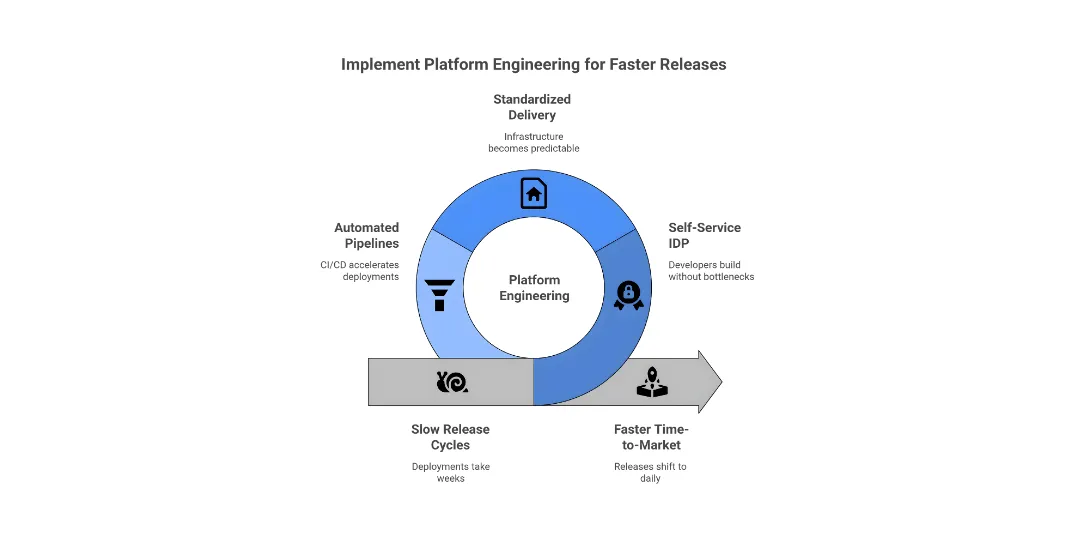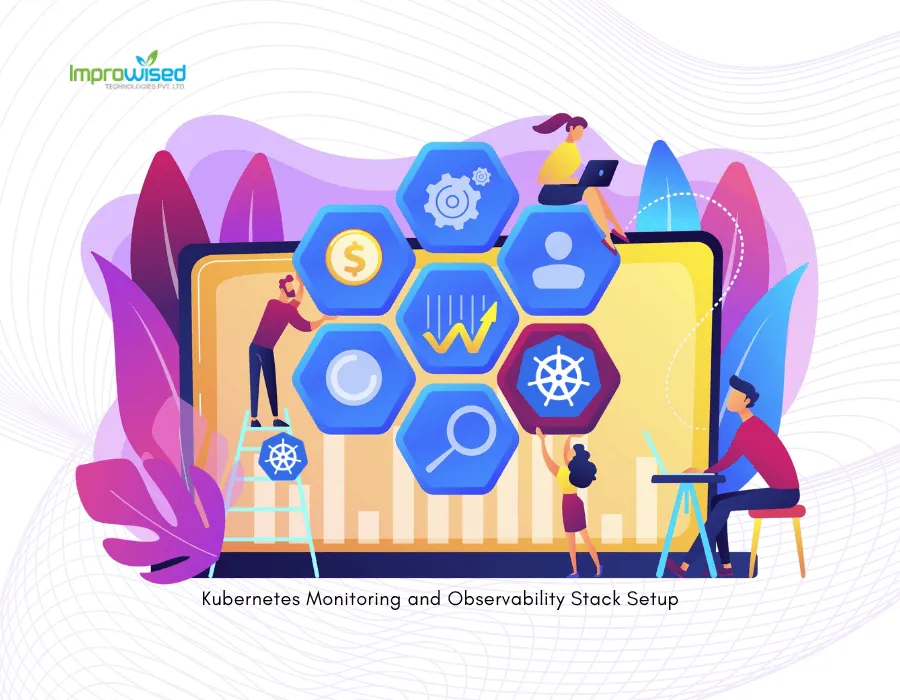November 5, 2025
7 Signs Your Organization Needs Platform Engineering

By Priyank Dhami
Improwised Technologies Pvt. Ltd.
7 Signs Your Organization Needs Platform Engineering
Engineering speed isn’t optional anymore - it’s survival. Companies that release faster, with stability and control, lead their industries. The rest play catch-up. Yet most engineering teams are not limited by talent or creativity - they’re limited by tangled infrastructure, sluggish deployments, and tool sprawl.
That’s where Platform Engineering enters.
It’s not another DevOps trend. It’s a systematic shift - building a self-service Internal Developer Platform (IDP) that lets developers build, test, and ship without bottlenecks. It standardizes delivery and makes infrastructure predictable. The result? Developers focus on product innovation instead of provisioning servers.
But when exactly does an organization become ready for Platform Engineering? Let’s break it down - seven clear signals that it’s time to make the leap.

1. Developers Spend More Time Managing Infrastructure Than Writing Code
Developers should be writing code, not juggling Terraform scripts or debugging flaky CI pipelines. If half your team’s energy goes into managing Kubernetes clusters or configuring environments, something’s broken.
The Challenge
As companies scale, so does infrastructure complexity. Manual environment setups, configuration drift, and fragmented processes creep in. One small update in staging breaks production. Over time, developers burn out and release velocity drops.
How Platform Engineering Fixes It
By implementing a self-service internal platform, you eliminate dependency on manual processes. Developers get:
- On-demand environment provisioning through tools like Terraform, Crossplane, or Pulumi.
- Reusable templates for consistent infrastructure setups.
- Automated pipelines connected to version control.
With the adoption of the platform engineering services, teams get frictionless access to pre-approved resources, so coding, not firefighting, becomes the focus.
Also Read: How Internal Developer Platforms Reduce Deployment Times by 2-3x
2. Release Cycles Are Slowing Down
If deploying to production feels like a multi-day process full of approvals and manual QA, your delivery model isn’t keeping pace.
The Challenge
As products evolve, pipelines that once worked become brittle. Manual testing, inconsistent environments, and slow rollouts lead to stagnation.
How Platform Engineering Fixes It
A platform-centric model accelerates everything:
- Continuous Integration for every commit - running tests, scans, and builds automatically.
- Continuous Deployment with GitOps-driven rollouts using FluxCD or ArgoCD.
- Deployment visibility and rollback are baked into the workflow.
Improwised Technologies’ clients in SaaS and healthcare moved from 3-week release cycles to 3 days - maintaining compliance while scaling safely.
A stable CI/CD pipeline is no longer a luxury; it’s the backbone of velocity.
3. “It Works on My Machine” Keeps Coming Up
That phrase is every team’s silent scream. It signals one thing - environment drift.
The Challenge
Local, staging, and production rarely match perfectly. When configs or dependencies vary, releases fail. Debugging these inconsistencies wastes hours - sometimes days.
How Platform Engineering Fixes It
By enforcing parity and version control:
- Infrastructure as Code (IaC) ensures every environment is reproducible.
- GitOps pipelines keep the actual state synced with code.
- Prebuilt environment blueprints eliminate manual setup.
The outcome? One configuration to rule them all. What runs locally will run in production without any surprises or excuses.
4. Scaling Infrastructure Feels Manual and Reactive
If you’re scaling only after getting alerts or customer complaints, your infrastructure strategy is reactive and risky.
The Challenge
Manual scaling leads to either wasted cloud spend (from overprovisioning) or outages (from underprovisioning). Both cost money and reputation.
How Platform Engineering Fixes It
Modern platforms introduce predictive and automated scaling:
- Autoscaling policies for workloads and databases.
- Performance-based adjustments based on CPU, memory, or custom metrics.
- FinOps dashboards (Kubecost, Azure Cost Management) for cost visibility.
Our company integrates Kubernetes-based scaling mechanisms with financial insight, cutting costs by 30–50%. Infrastructure becomes elastic and not chaotic.
5. Security and Compliance Are Afterthoughts
If access control still happens via chat messages or secrets live in shared docs, you’re running on borrowed time.
The Challenge
Every service, container, and environment expands your attack surface. Manual credential management and delayed security reviews mean vulnerabilities often reach production.
How Platform Engineering Fixes It
Security becomes part of the delivery fabric:
- IAM and RBAC ensure least-privilege access.
- Secrets management is centralized with Vault or AWS Secrets Manager.
- Automated SAST, DAST, and IaC scans are built into CI/CD.
- Compliance as Code enforcing ISO 27001, SOC 2, and GDPR.
With Improwised Technologies’ frameworks, security shifts are left-embedded in development, not bolted on later.
6. Your DevOps Team Is Overwhelmed
DevOps should be building automation, not responding to a queue of tickets. Yet, in many organizations, DevOps becomes a bottleneck.
The Challenge
Without automation and self-service, developers rely on DevOps for every deployment, permission, or config tweak. That kills momentum and morale.
How Platform Engineering Fixes It
By empowering both sides:
- Developers self-serve environments, deploys, and rollbacks safely.
- Guardrails maintain governance without friction.
- Observability tools give teams transparency without manual status checks.
One of our clients saw a 60% drop in operational tickets post-IDP rollout. DevOps moved from reactive firefighting to proactive optimization.
Also Read: platform engineering vs DevOps: Which one is best for your company?
7. You’re Scaling Fast, but Your Tooling Isn’t
Growth exposes weaknesses. If your infrastructure feels cobbled together with overlapping dashboards, random scripts, and duplicated configs. Then, you’re past the point of manual fixes.
The Challenge
Scaling without standardized tooling results in:
- Environmental sprawl.
- Rising costs.
- Governance gaps.
- Difficult onboarding for new hires.
How Platform Engineering Fixes It
- Version-controlled architecture that grows modularly.
- Unified observability stack with Grafana, Loki, and OpenTelemetry.
- Automated policy enforcement for compliance and costs.
- Onboarding automation for new teams and services.
Improwised builds cloud-agnostic IDPs that evolve with your business - AWS, Azure, GCP, or hybrid. Predictable scaling, consistent delivery.
Platform Engineering Is a Mindset, Not a Toolset
Tools matter, but mindset drives transformation. Platform Engineering isn’t about adding another dashboard; rather, it’s about enabling independence, repeatability, and safety across teams. It turns delivery into a product discipline.
At Improwised Technologies, we say: “Stop building tools. Start building systems that make tools work together”.
The Business Case: Platform Engineering ROI
| Benefit | Business Outcome |
|---|---|
| Faster time-to-market | Releases shift from monthly to daily |
| Lower operational costs | Automation reduces waste and manual effort |
| Improved developer productivity | Developers focus 80%+ on code, not ops |
| Enhanced reliability | Fewer incidents, faster recovery |
| Continuous compliance | Policies enforced automatically |
| Predictable scalability | Growth without chaos |
Case Study - From 3 Weeks to 3 Days
A healthcare company came to Improwised Technologies with long deployment cycles and unstable infrastructure. Their release cycle took three weeks. After implementing a custom IDP with GitLab CI, FluxCD, and Kubernetes:
- Releases dropped to 3 days.
- Over 7,000 releases per year.
- 50% reduction in cloud spend.
- Improved visibility and compliance.
That shift changed not just delivery speed - but the way teams thought about deployment ownership.
Ready for Platform Engineering?
If three or more of these signs sound familiar, your organization is ready. Improwised Technologies platform engineering consultants design, implement, and scale IDPs that combine automation, observability, and compliance. Our frameworks are modular, cloud-agnostic, and cost-optimized, and they are hence perfect for scaling enterprises and fast-moving startups alike.
Frequently Asked Question
Get quick answers to common queries. Explore our FAQs for helpful insights and solutions.

November 7, 2025
How to Troubleshoot Kubernetes: Identify and Fix Issues Like a Pro

By Shyam Kapdi
Improwised Technologies
Pvt. Ltd.


By Shyam Kapdi
Improwised Technologies
Pvt. Ltd.

October 31, 2025
Kubernetes Monitoring and Observability Stack Setup: Best Tools and Cost Monitoring

By Improwised Editorial Team
Improwised Technologies
Pvt. Ltd.
Optimize Your Cloud. Cut Costs. Accelerate Performance.
Struggling with slow deployments and rising cloud costs?
Our tailored platform engineering solutions enhance efficiency, boost speed, and reduce expenses.
